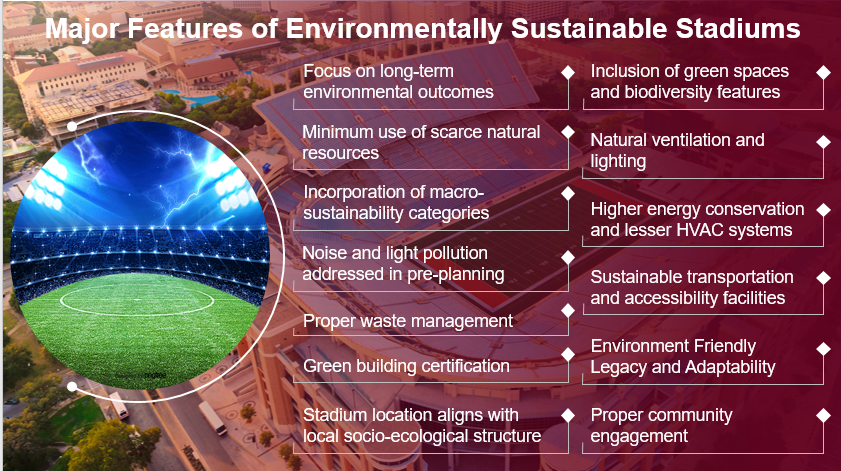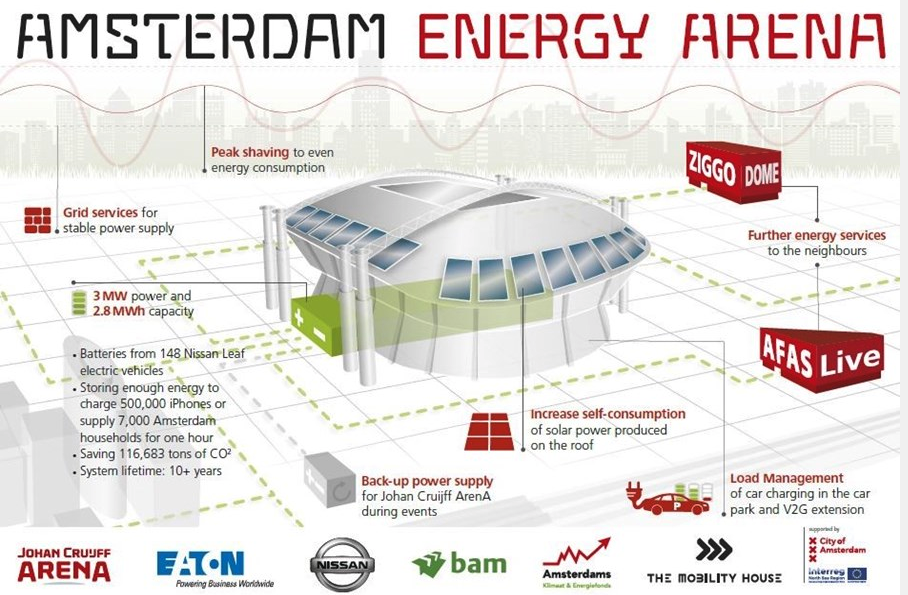“Perhaps no other industry is as well suited to confirm that environmental stewardship has become a mainstream, non-partisan issue as the sports industry.” – Dr Allen Hershkowitz, Natural Resources Defense Council’s Senior Scientist
Like all other domains, the transformation catalysts here are top-tier players. They are shaping the development and revitalization of the local urban community. World Cup stadiums are the biggest mega-event hosts, with capacities going as high as 80,000 to 1 32,000. Often, these establishments come under criticism for negative environmental impact due to high footfalls, associated infrastructure, and non-eco-friendly event management practices. For instance, the carbon footprint for the 2022 FIFA World Cup exceeded 3.6 million tonnes. The preparations of these stadiums cause 72% of these emissions.
The value proposition of these eco-hazardous establishments comes under deep scrutiny as they become white elephants after the events. For instance, the ICC is working diligently to neutralize the ecological impact of this 48-match event that is the center of global attention at the moment. But despite all efforts, the carbon footprint of the slated 2023 World Cup venues remains high and intact.
Nevertheless, several important opportunities exist to optimize resource usage and carbon emissions from such mega-events. We have narrowed down a few to shape the idea of Environmentally Sustainable Stadiums (ESS).
What Are Environmentally Sustainable World Cup Stadiums?
Environmentally Sustainable Stadiums, or ESS, are sports facilities designed, built, and run in adherence to carbon neutrality goals. It was established by the Paris Agreement and the United Nations Sustainable Development Goals (UNSDGs). The primary aim across all stages remains the reconciliation of the social, economic, and environmental interests of its surrounding locality. Key characteristics of an ESS include complete energy efficiency, optimum water consumption, and zero or minimum waste generation. Besides, sustainable materials and availability of non-fossil-fuel-based transportation and accessibility.
Possibilities Constituting Environmentally Sustainable World Cup Stadiums
In July 2023, Australia stepped back from supporting the next Commonwealth Games due to rising costs and environmental concerns. The irony is that it isn’t the first nation to do that since the last Commonwealth. It implies that the challenges related to global game models are way bigger and need to move beyond the established sustainability and legacy norms. Both carbon neutrality and costs have compelled even developed nations to rethink the plan. With respect to huge establishments like the Olympics, Commonwealth, Cricket, and Football stadiums, a number of practices can be adopted to bring the desired change
Bring long-term environmental outcomes in focus:
World Cup stadiums are expensive and permanent structures that consume several scarce natural resources in large quantities for construction, maintenance, and day-to-day operations. The large-scale public gatherings in such places often imbalance the local ecology for a considerable extent of time. The good thing is that stadium architectures are often imitated. Therefore, even if one project sets a benchmark for minimal use of natural resources, the other will easily follow.
Integrating Macro-Sustainability Categories In ESS:
Most initiatives and efforts in sustainable construction or management of World Cup stadiums focus primarily on two categories: materials and energy. Their sole focus remains on minimizing energy consumption and elevating aero-thermal comfort inside the stadium. Materials come next, including locally sourced and waste materials. Other aspects, such as water consumption, noise pollution, indoor air quality, and light pollution caused by these mega-sized establishments, still require investigation.

Image 1: A Glimpse Into The Possibilities of Environment-Friendly World Cup Stadiums
- Green Building Certification: It is a highly recommended measure that has yet to be exercised. No environmental sustainability assessment tool has been developed for such goliath structures. This is also one of the prime reasons stadium renovation, construction, and design still lag behind other green building practices. A well-regulated system must be established to enforce some sustainability standards and prerequisites for stadium managers, operators, and sports organizations. None of these complexes should contradict the socio-economic-ecological balance of their locality.
- Better Thought Through Planning: The sustainability issue of World Cup stadiums came to light in 2022 with the FIFA World Cup. Several initiatives have been in place to minimize the footprint since then. Nevertheless, there are several loopholes in these efforts. The biggest one is that most of these are single phase-oriented steps, but none keep the complete life cycle in view. A holistic sustainability perspective must range from concept to site selection, design, construction, daily operations, and decommissioning. Wouldn’t it be amazing if every stadium plan included directions or details about its postgame engagement plans, market analysis, and checking out the local demands to ensure the stadium remains in use even after global events?
Real-Life Initiatives To Ensure Sustainability of World Cup Stadiums
Mercedes-Benz Arena, Atlanta: Also known as Peach Bowl, is one of the first stadiums to achieve Leadership in Energy and Environmental Design (LEED). It has been making significant strides in economizing its water consumption through rainwater cisterns. Moreover, it’s renowned for high-efficiency toilets that are plugged into the stadium’s cooling and irrigation system. Through this move, the stadium registered 47% savings in water usage. It has also optimized 29% of its power consumption through the use of solar power.
Tottenham Hotspur Stadium, London: Built to replace the famous While Hall Lane, Tottenham Hotspur was built keeping energy economics in view. Its thermal and insulation system has been constructed with 100% renewable materials. The rainwater collection system also maintains the restrooms, which have waterless urinals. The complete lighting system is LED-based, which reduces energy consumption. Lastly, it also focuses on minimizing food wastage by distributing the leftovers to the local food banks after every event.
Johan Cruijff Arena: Located in Amsterdam, it is equipped with over 4,200 solar panels. It stores all energy in retired electric vehicle batteries. Its large capacity supports the stadium and the surrounding areas in an hour of need. The rainwater harvesting system on its roof helps water the ground, making it one of the top-ranked and greenest World Cup Stadiums.

Image 2: Johan Cruijff Arena Design Plan
Conclusion
Sustainable sports venues hold an important place in the 15-minute city concept smart cities concept. Therefore, every aspect needs careful planning and deep research. There is a big gap between available data, literature, information, and emerging technology. Future studies and surveys need to include industry-specific reports to evaluate the role of ESS in an ecologically balanced world. Also, it is important to conduct additional research. That can help generate concrete ideas on how to synchronize the energy networks of the new and old stadiums with a smart grid architecture. Urban development authorities and the International Sports Association need to work hand-in-hand to ensure the incorporation of green practices, complete stadium life cycles, and macro-ecological factors in stadium renovation and construction.